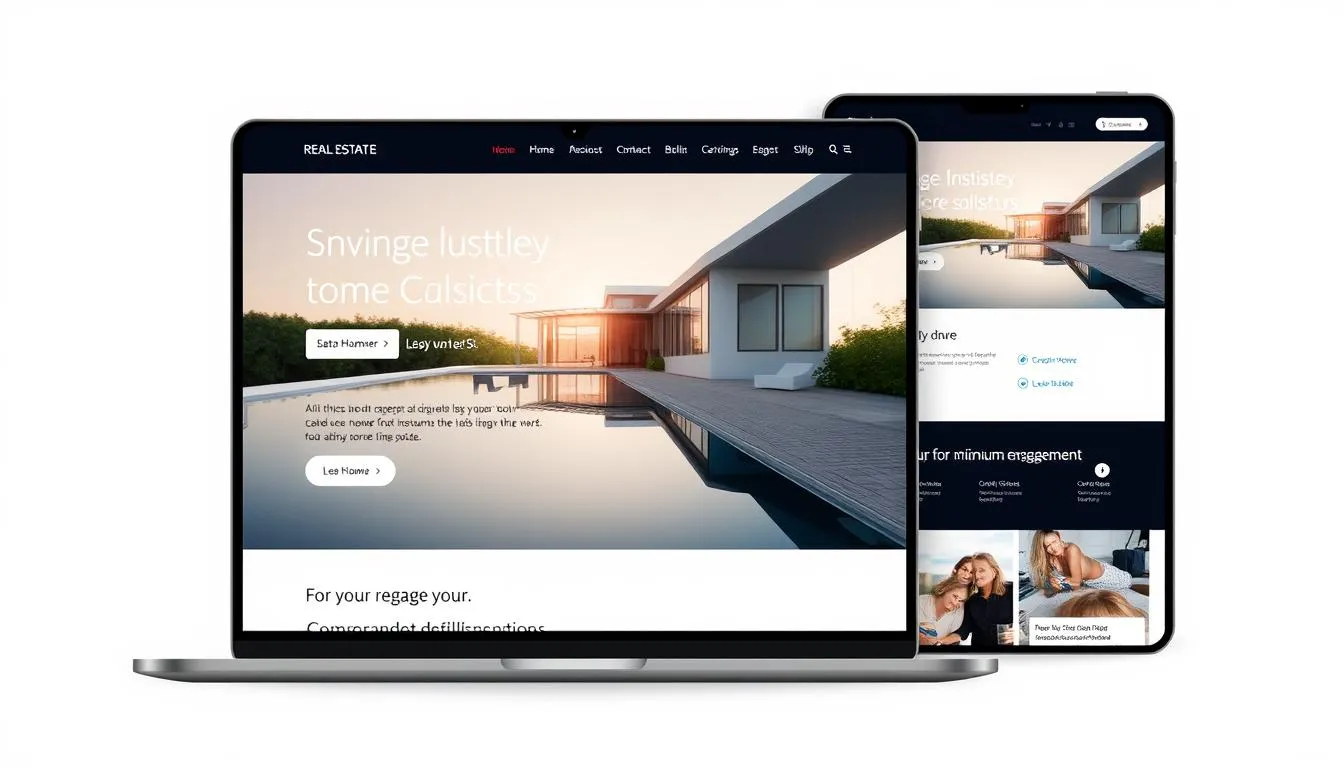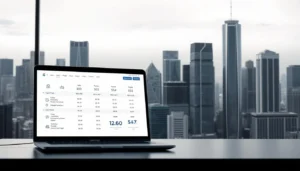Last Updated on: June 19, 2025
In today’s digital age, having a well-designed real estate website is crucial for attracting potential clients and generating leads. A website that is optimized for maximum engagement can make all the difference in the competitive real estate market.
A well-optimized website not only showcases your listings but also provides a seamless user experience, encouraging visitors to explore and interact with your site. By focusing on real estate website optimization, you can improve your online presence and stay ahead of the competition.
Key Takeaways
- Improve your website’s user experience to boost engagement
- Optimize your website’s design for better conversion rates
- Use relevant keywords to enhance your website’s visibility
- Create engaging content to attract and retain potential clients
- Ensure your website is mobile-friendly and accessible
The Critical Role of Website Optimization in Real Estate Success
In the competitive world of real estate, having a website that is both visually appealing and optimized for search engines is critical for capturing leads and driving sales. A well-optimized website serves as the foundation of a real estate agent’s online presence, providing potential clients with their first impression of the agent’s brand and services.
Current Digital Landscape in Real Estate
The real estate industry has experienced a significant shift towards online platforms, with the majority of homebuyers and sellers turning to the internet to search for properties and real estate services. A robust online presence is no longer a luxury but a necessity for real estate agents looking to expand their client base. According to recent statistics, over 90% of homebuyers start their search online, highlighting the importance of having a strong digital footprint.
How Website Performance Impacts Lead Generation
Website performance plays a crucial role in lead generation for real estate agents. A slow or unresponsive website can deter potential clients, resulting in lost opportunities. Optimizing website elements such as loading speed and mobile responsiveness is essential to ensure a smooth user experience and encourage visitors to explore the site further. A study by Google found that 53% of mobile users will abandon a site if it takes more than three seconds to load, underscoring the need for fast and efficient website performance.
As real estate professionals continue to navigate the digital landscape, prioritizing website optimization will be key to achieving success and generating leads.
Understanding Your Real Estate Website Audience
To create an engaging real estate website, it’s crucial to comprehend the diverse needs of your audience. Understanding your target audience is fundamental in designing a website that not only attracts but also retains potential clients.
Buyer vs. Seller Personas
Real estate websites cater to two primary personas: buyers and sellers. Buyers are often looking for detailed property information, including pricing, location, and amenities. On the other hand, sellers are interested in understanding the market value of their properties, the selling process, and how to maximize their returns.
Creating buyer and seller personas helps in tailoring the website’s content and features to meet their specific needs, thereby enhancing user experience.
Tailoring User Experience to Different Client Types
Different clients have different needs when it comes to browsing real estate websites. For instance, first-time homebuyers may require more guidance on the home buying process, while luxury property seekers might be looking for high-end finishes and exclusive neighborhood information.
First-Time Homebuyers
For first-time homebuyers, providing educational content and easy-to-use property search tools can significantly enhance their browsing experience. A step-by-step guide to the home buying process can be particularly helpful.
Luxury Property Seekers
Luxury property seekers, on the other hand, are often drawn to high-quality visuals and detailed property descriptions. Incorporating virtual tours and high-resolution property images can cater to their preferences.
By understanding and catering to the diverse needs of your audience, you can create a more engaging and effective real estate website.
Essential Elements of High-Converting Real Estate Websites
In the competitive world of real estate, having a website that converts visitors into leads is crucial for success. A high-converting real estate website is designed to provide a user-friendly experience that caters to the diverse needs of potential clients.
Property Search Functionality
One of the critical features of a high-converting real estate website is its property search functionality. This feature allows potential buyers to easily find properties that match their criteria, enhancing their overall user experience. An effective property search should include filters for location, price range, property type, and other relevant criteria.
Lead Capture Forms
Lead capture forms are another essential element, enabling potential clients to express their interest in properties or request more information. These forms should be strategically placed throughout the website, such as on property listing pages or in the footer. Keeping the form fields minimal can also improve completion rates.
Neighborhood Information
Providing detailed neighborhood information can significantly enhance the user experience. This can include data on local schools, community amenities, and market trends. By offering valuable insights into the neighborhoods they serve, real estate websites can establish themselves as trusted resources, fostering trust with potential clients.
By incorporating these essential elements, real estate websites can improve their conversion rates, ultimately driving more leads and sales.
How to Design a Real Estate Website for Higher Engagement?
Creating an engaging real estate website requires a thoughtful design approach. A well-designed website not only attracts potential clients but also retains them by providing a seamless user experience.
Visual Hierarchy Principles
A well-structured visual hierarchy is crucial for guiding users through your website. It involves organizing content in a way that draws attention to the most important elements first. Use size, color, and positioning to create a clear visual flow that directs users to key information such as property listings and search functionality.
Color Psychology in Real Estate Websites
Colors significantly influence user emotions and perceptions. In real estate website design, certain colors can evoke feelings of trust and stability. For instance, blues and greens are often associated with reliability and growth. Choose a color scheme that aligns with your brand values and resonates with your target audience.
Navigation Best Practices
Intuitive navigation is key to a positive user experience. It ensures that visitors can easily find the information they’re looking for.
Clear Call-to-Action Buttons
Use prominent call-to-action (CTA) buttons to guide users toward desired actions, such as contacting your agency or scheduling a viewing. CTAs should be visually distinct and placed strategically throughout the site.
Intuitive Menu Structure
An intuitive menu structure simplifies navigation by categorizing content logically. Ensure that your menu is easily accessible and understandable, allowing users to quickly locate property listings, neighborhood information, and other relevant sections.
Mobile Optimization Strategies for Real Estate Websites
With the majority of homebuyers now using mobile devices to search for properties, having a mobile-optimized real estate website is no longer a luxury, but a necessity. A well-optimized mobile website can significantly enhance user experience, leading to higher engagement and conversion rates.
Responsive Design Essentials
A responsive design is the foundation of a mobile-optimized website. It ensures that your website adapts seamlessly to different screen sizes, providing an optimal viewing experience across various devices. Key elements of responsive design include:
- Flexible grid systems that adjust to screen size
- Images that scale appropriately
- Media queries that apply different styles based on device characteristics
By incorporating these elements, you can ensure that your website is accessible and visually appealing on both desktop and mobile devices.
Mobile-Specific Features for Property Browsing
In addition to responsive design, incorporating mobile-specific features can further enhance the property browsing experience on mobile devices. Two crucial features to consider are:
Touch-Friendly Interface Elements
A touch-friendly interface is essential for a smooth mobile experience. This includes:
- Large, easily clickable buttons
- Simplified navigation menus
- Easy-to-use form fields
Location-Based Search Options
Location-based search allows users to find properties based on their current location or a specific area they’re interested in. This feature can be implemented using:
- Geolocation technology to detect user location
- Map views to visualize property locations
- Filters to narrow down search results based on location
By integrating these mobile-specific features, you can create a more engaging and user-friendly experience for potential clients browsing properties on their mobile devices.
Creating Compelling Visual Content for Property Listings
Visual content plays a crucial role in showcasing property listings effectively, making it a top priority for real estate professionals. High-quality visuals not only attract potential buyers but also provide them with a comprehensive understanding of the property.
Professional Photography Guidelines
Professional photography is essential for capturing the best features of a property. To achieve this, photographers should use high-resolution cameras and pay attention to lighting. Natural light is particularly effective in showcasing the interior of properties.
- Use a wide-angle lens to capture more of the room.
- Minimize clutter and stage the property attractively.
- Take photos from multiple angles to provide a comprehensive view.
Virtual Tours and 3D Walkthroughs
Virtual tours and 3D walkthroughs offer potential buyers an immersive experience, allowing them to explore properties remotely. These tools are particularly valuable in today’s digital age, where many buyers start their property search online.
Benefits of virtual tours include:
- Increased engagement with potential buyers.
- Better visualization of the property layout.
- Reduced need for physical visits, saving time for both buyers and agents.
Video Content Best Practices
Video content is another powerful tool for showcasing properties. It can be used to create engaging property highlight videos and agent introduction videos.
Property Highlight Videos
These videos should focus on the key features of the property, such as its architecture, interior design, and surrounding amenities. Drone footage can be particularly effective in showcasing the property’s exterior and neighborhood.
Agent Introduction Videos
Agent introduction videos help establish a personal connection with potential clients. They should be friendly, informative, and include details about the agent’s experience and areas of expertise.
Content Marketing Strategies to Engage Potential Clients
Content marketing offers a powerful means for real estate professionals to connect with potential clients and foster meaningful relationships. By creating valuable and relevant content, real estate professionals can establish themselves as trusted authorities in their local markets.
One effective content marketing strategy involves the creation of neighborhood guides and market reports. These resources provide potential clients with valuable insights into local real estate trends, helping to build trust and credibility.
Neighborhood Guides and Market Reports
Neighborhood guides and market reports are excellent tools for engaging potential clients. They offer detailed information about local neighborhoods, including market trends, property values, and community amenities. By providing this information, real estate professionals can demonstrate their expertise and show their commitment to helping clients make informed decisions.
Educational Content for First-Time Buyers
Educational content is another crucial aspect of content marketing in real estate. First-time buyers, in particular, benefit from informative resources that explain the home buying process, outline the benefits of different mortgage options, and provide tips for navigating the real estate market.
Seller Resources and Tips
In addition to educational content for buyers, real estate professionals can also create valuable resources for sellers. This can include tips on how to stage a home for sale, advice on pricing strategies, and guidance on how to navigate the selling process. By providing these resources, real estate professionals can attract potential clients and establish themselves as trusted advisors.
Implementing IDX and MLS Integration for Better User Experience
IDX and MLS integration is crucial for real estate websites aiming to offer a comprehensive and current property search experience. By incorporating these technologies, real estate professionals can significantly enhance their website’s functionality, providing users with accurate and up-to-date property listings.
Benefits of Real-Time Listing Updates
One of the primary advantages of IDX and MLS integration is the ability to provide real-time listing updates. This ensures that the property listings on your website are always current, reflecting the latest changes in the market. As a result, potential buyers can trust the information they find on your site, leading to increased user satisfaction and engagement.
- Accurate and timely property information
- Enhanced user trust and satisfaction
- Increased engagement due to reliable data
Customizing IDX Search Features
Customizing IDX search features is essential for creating a user-friendly experience on your real estate website. By tailoring the search functionality to meet the specific needs of your users, you can make it easier for them to find their desired properties.
Saved Searches and Favorites
Allowing users to save their searches and mark favorite properties can significantly enhance their browsing experience. This feature enables potential buyers to easily track properties they’re interested in and receive updates when new listings match their saved searches.
Property Alerts and Notifications
Implementing property alerts and notifications is another effective way to keep users engaged. By sending notifications when new listings become available or when there’s a change in the status of a property they’re interested in, you can encourage users to return to your website and continue their property search.
Local SEO Tactics for Real Estate Professionals
In the competitive world of real estate, local SEO tactics can make all the difference in reaching local clients. By optimizing your online presence for local search, you can increase your visibility, drive more traffic to your website, and ultimately generate more leads.
Google Business Profile Optimization
Optimizing your Google Business Profile is a critical step in local SEO. This involves claiming your listing, verifying your business, and ensuring that your profile is complete and accurate. Include relevant keywords in your business description, and make sure your categories are correctly selected. Regularly posting updates and responding to reviews can also enhance your profile’s visibility.
Neighborhood-Specific Landing Pages
Creating neighborhood-specific landing pages can help you target specific areas and attract local clients. These pages should include relevant content about the neighborhood, such as local amenities, schools, and market trends. Ensure that each page is optimized with local keywords and has a clear call-to-action.
Local Keyword Strategies
Implementing local keyword strategies involves identifying and incorporating keywords that potential clients might use when searching for real estate services in your area. Use tools like Google Keyword Planner to find relevant keywords, and incorporate them naturally into your website’s content, meta tags, and headings.
Lead Generation Tools and Features for Real Estate Websites
To maximize the potential of a real estate website, incorporating robust lead generation tools is essential. Lead generation tools help in capturing potential client information, enabling real estate professionals to follow up and potentially convert these leads into clients.
Home Valuation Tools
Home valuation tools provide potential clients with an instant estimate of their property’s value. This feature not only attracts visitors but also encourages them to engage further with the website. By offering accurate and up-to-date valuations, real estate professionals can establish trust with potential clients.
Mortgage Calculators
Mortgage calculators are another valuable feature that can be integrated into real estate websites. These calculators help potential buyers understand their financial commitments, making them more likely to engage with the website and seek further assistance. Ease of use and accuracy are key factors in the effectiveness of mortgage calculators.
Newsletter Signup and Lead Magnets
Encouraging visitors to sign up for newsletters and offering lead magnets such as downloadable buyer/seller guides and market report subscriptions can significantly boost lead generation. These resources provide value to potential clients while capturing their contact information for future follow-ups.
Downloadable Buyer/Seller Guides
Downloadable guides offer comprehensive information tailored to the needs of buyers and sellers. By providing valuable insights, real estate professionals can attract potential clients and establish their authority in the market.
Market Report Subscriptions
Market report subscriptions keep potential clients informed about the latest trends and developments in the real estate market. This ongoing engagement helps build a loyal audience and can lead to increased conversions over time.
Analytics and Performance Tracking for Continuous Improvement
To maximize the potential of a real estate website, it’s crucial to implement analytics and performance tracking. This involves monitoring various aspects of the website to understand how users interact with it and identifying areas that need improvement.
Key Metrics for Real Estate Websites
Real estate websites should track key metrics such as page views, bounce rates, and conversion rates. Page views help understand which content is most popular, while bounce rates indicate whether the landing pages are engaging enough. Conversion rates measure the success of lead generation efforts.
A/B Testing Strategies
A/B testing, or split testing, is a method of comparing two versions of a web page to see which one performs better. Real estate websites can use A/B testing to optimize elements like call-to-action buttons, property listing layouts, and search functionalities.
User Behavior Analysis
Analyzing user behavior helps in understanding how visitors navigate the website, what they are looking for, and where they drop off. Tools like heatmaps and session recordings can provide insights into user behavior, enabling data-driven decisions to improve the website.
Conclusion: Building a Real Estate Website That Converts
Creating a real estate website that drives conversions requires a strategic approach to design and functionality. By understanding your target audience and incorporating essential elements such as property search functionality and lead capture forms, you can significantly enhance user engagement.
Effective website design best practices play a crucial role in real estate website conversion. A well-designed website not only attracts potential clients but also provides them with a seamless browsing experience, encouraging them to take action.
To maximize your website’s potential, focus on mobile optimization, compelling visual content, and content marketing strategies. By implementing these strategies and tracking your website’s performance through analytics, you can continually refine and improve your online presence.
By following the guidelines outlined in this article, you can build a real estate website that effectively converts visitors into leads, driving success in your real estate business.
FAQ
What are the essential elements of a high-converting real estate website?
The essential elements include property search functionality, lead capture forms, and neighborhood information, which help attract potential clients and generate leads.
How can I optimize my real estate website for mobile devices?
To optimize your website for mobile devices, use responsive design, touch-friendly interface elements, and location-based search options to enhance the user experience.
What is the importance of visual content in property listings?
High-quality visual content, such as professional photography, virtual tours, and video content, is vital for showcasing property listings effectively and attracting potential clients.
How can I use content marketing to engage potential clients?
Create neighborhood guides, market reports, educational content for first-time buyers, and resources for sellers to engage potential clients and establish your authority in the real estate market.
What are the benefits of integrating IDX and MLS into my real estate website?
Integrating IDX and MLS provides real-time listing updates, customizable search features, and enhanced user experience, which can lead to increased engagement and lead generation.
How can I improve my website's local SEO?
Optimize your Google Business Profile, create neighborhood-specific landing pages, and implement local keyword strategies to improve your website’s visibility in local search results.
What lead generation tools can I use on my real estate website?
Use home valuation tools, mortgage calculators, newsletter signup options, and lead magnets like downloadable buyer/seller guides and market report subscriptions to generate leads.
How can I track the performance of my real estate website?
Use analytics to track key metrics, conduct A/B testing, and analyze user behavior to identify areas for improvement and optimize your website’s performance.
What is the role of color psychology in real estate website design?
Color psychology plays a crucial role in creating an engaging and user-friendly website, as different colors can evoke emotions and influence user behavior.
How can I design a real estate website with a clear visual hierarchy?
Organize content using visual hierarchy principles, drawing the user’s attention to the most important elements, such as property listings and call-to-action buttons.




